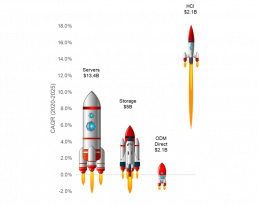Unmanned aerial vehicles (drones) are one of the most recognisable technologies to have emerged in recent years, and one of the fastest-growing areas of the Internet of Things (IoT). They’re so popular, you can even find them on Mars.
The Mars Perseverance Mission Autonomous Flying Drone
Ingenuity is a small flying drone that is part of the successful Perseverance mission to Mars. Flight controllers on Earth can’t control the drone with a joystick. It takes 5–20 minutes for a signal to reach Earth and another 5–20 minutes to reach Mars with a decision. Communication delays are an inherent part of working across interplanetary distances and therefore Ingenuity has been built with significant autonomy to make its own flying decisions.
Ingenuity Takes Hyperconvergence to New Heights
Though Ingenuity is a long fetch interplanetary IoT use case, there are plenty of IoT use cases where even a decision in the public cloud or enterprise datacentre is not fast or reliable enough. Industry-specific use cases will rocket boost edge computing and break the gravity barrier to take it to new heights.
Rocket Launchpad for Edge Infrastructure
IDC defines edge as the technology-related actions that are performed outside of the centralised datacentre, where edge is the intermediary between the connected endpoints and the core IT environment. Edge is distributed, software defined and flexible.
Compute and storage need to be close to IoT devices (at the edge) to ensure fast data processing, real-time analytics and scalability while maintaining ultra-low latency and availability. When combined with AI it enables fast decisions in processes that cannot be interrupted.
According to IDC research, a quarter of storage and server spending in Europe will be outside the core datacentre by 2025. The most important domain for edge solutions is IoT, accounting for over 50% of edge-related spending. At the same time, hyperconverged infrastructure (HCI) is the fastest-growing technology in the enterprise infrastructure market (at a CAGR of +16%) (see Figure 1) and it’s no surprise that IoT is fuelling some of this growth.
Figure 1
Though not the only edge technology available, HCI is becoming a prime candidate for some of the vertical solutions needed for OT/IT convergence, with a strong case in the IoT arena.
Digital Agendas Drive IoT Industry Use Cases
According to IDC’s Worldwide Internet of Things Spending Guide, Forecast 2021, manufacturing, retail, transportation and public sector are not only the most popular industry verticals for IoT in Europe but also the fastest-growing spenders in compute and storage for emerging workloads.
Some IoT use cases rely heavily on edge infrastructure (server and storage) such as smart factory asset management, predictive maintenance, process automation and energy consumption optimisation. IoT is becoming mainstream, and it’s now virtually everywhere — from autonomous vehicles like Ingenuity to smart agriculture.
Smart city projects driven by public sector digital agendas include video surveillance, traffic control and resource management, while sustainably connecting and securing their public spending.
Retail IoT use cases are focused on customer experience such as personalised accounts and in-store layout optimisation or improvement of processes (smart shelves, supply chain optimisation).
Though HCI is not new to the edge, it’s getting optimised and is being quickly deployed with a number of connected devices needing ultra-low latency, specifically for real-time AI decision making and analytics.
While many enterprises have still not discovered the full potential of HCI for edge use cases, the highest number (54%) believe the technology is moderately important for supporting such workloads. Even though most users believe it is not crucial at this stage, they recognise HCI’s potential for edge deployments in the future, especially the digital leaders that set the market trends.
Figure 2
The Vendor Edge (Space) Race
Infrastructure vendors and industrial solutions leaders alike see HCI as an excellent fit for edge and IoT use cases, and are positioning their HCI product lines to respond to these growing workloads. Cisco HyperFlex, HPE Simplivity, Nutanix and Dell VxRail, to name a few, are examples of such hyperconverged solutions. IBM has just entered the hyperconverged space too. Siemens’ industrial IoT solutions rely entirely on HCI from infrastructure vendors to offer IoT solutions such as Schneider’s EcoStruxure Micro Data Centers.
Ingenuity Inspires Datacentre Infrastructure on Wheels
Datacentre infrastructure and in particular HCI is mobilising where the workload is needed and it’s fast moving to the edge, bringing ultra-low latency, high availability, effectiveness, mobility and ease of use. The concept of “datacentres on wheels”, or on rotor blades for self-driving drones already deployed on Mars, will continue to evolve as outer space technologies are exploited here on Earth and HCI enables similarly advanced solutions.
To learn more about our upcoming research, please contact Marina Kostova, or head over to https://www.idc.com/eu and drop your details in the form on the top right.



